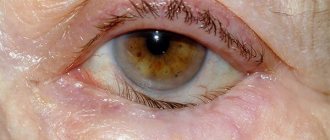People with uneven coloration of the iris or with eyes that have different shades of the iris (heterochromia) attract the attention of others with their unusual appearance.
This condition can signal a serious illness, so people with this appearance feature need to consult an ophthalmologist and undergo a medical examination. Timely seeking help will prevent the pathology from reaching an advanced stage.
What is ocular heterochromia?
As you know, in genetics there are only three pigments that can determine what eye color nature will reward us with. These are blue, brown and yellow pigments.
The color of our eyes is formed depending on their concentration and proportion. Usually a person has the same eye color, however, there are exceptions. Literally, the term “heterochromia” translates as “different color.” 1% of the world's population has a similar anomaly, that is, different or unevenly colored eyes.
This feature implies a partial change in pigmentation in one of the irises, which is why such a feature arises.
Causes of multi-colored eyes
What are the reasons for such an unusual phenomenon? Most often, this phenomenon is inherited at the genetic level. So, if one of your relatives has a similar feature, most likely it will be passed on to the future generation.
This anomaly does not cause any harm to the baby’s health and vision, and it can be noticed before the age of two. It is important to understand that eye heterochromia is not a disease, but an anomaly, a gene mutation that occurs immediately after fertilization of the egg. It does not affect vision or distort the color or shape of visible objects.
However, there is such a thing as acquired heterochromia. The reasons for its occurrence can vary: from minor injury to serious illness. In this case, it will already be a disease that has symptoms: deterioration or loss of vision, clouding of the eye lens, and in more serious cases, the development of cataracts (visual impairment, leading to its loss).
Also, an acquired mutation may indicate the presence of dangerous diseases such as cancer, Horner's syndrome, neurofibromatosis and others.
There are several types of heterochromia:
- Full. With this anomaly, human eyes have two completely different colors, and the iris is colored evenly and completely. The most common case is when one eye is colored brown and the other is blue. Almost always such a mutation is congenital.
- Partial. In such a situation, one of the irises turns several different colors. This phenomenon is also called sector heterochromia. Looking into such eyes, you can see several shades in the form of spots or sectors that differ from the main shade. For example, blue or gray spots can be seen on a brown background. Most often, such a mutation occurs as a result of a baby’s lack of one or another pigment. This anomaly can also occur as a result of injury. In this case, the resulting damage leads to improper distribution of pigment, resulting in an excess or lack of melanin in a certain area of the iris.
- Central. Very often, carriers of central heterochromia do not even suspect that they have heterochrony. This anomaly looks very unusual and is characterized by the presence of several color rings, creating a transition of colors from the center of the iris to its ends.
Types of heterochromia of the eyes in humans
Depending on the distribution of pigment, complete, partial (sector), central and metallic heterochromia are distinguished. Let's take a closer look at each type.
Complete heterochromia
This type is the most common. With it, the corneas of the eyes are colored differently, but evenly. The most common combinations are blue/brown and green/brown (brown will definitely be present). Complete heterochromia is not associated with diseases or pathologies, is always hereditary and does not at all affect the quality and acuity of a person’s vision.
Partial or sector heterochromia
With this feature, the iris of one eye is colored in different colors in half, in segments, or - much less often - in sectors with wavy borders. The cause of heterochromia lies in failures in the formation of eye color due to the uneven distribution of melanin in early childhood - from 1.5 to 2 years. Over time, if the pigment is redistributed as they grow older, the feature may disappear. Otherwise, it will remain for life. This type is also called sectoral heterochromia.
Central heterochromia of the eye in humans
Ring heterochromia consists of the appearance of differently colored circles-rings on the iris around the pupil.
Metallosous heterochromia
A special type of acquired heterochromia, which most often affects representatives of professions related to metal processing. The fact is that if a small bronze or copper particle gets into the eye and is not removed in time (this happens if it is very small and its size does not exceed several microns), it will begin to oxidize. When oxidized, a pigment will be released, most often a green tint. This pigment will result in a coloration of the iris that will remain even after the metal particle is removed.
In addition, there is a division of heterochromia into:
- congenital
(genetically determined) and acquired (due to injuries, tumors and other diseases, when taking certain medications and chemicals); - simple
(genetic or due to Horner's syndrome - weakness of the cervical bundle of nerves) and complicated. A prerequisite for the occurrence of complicated heterochromia is Fuchs syndrome. Its symptoms: damage to only one eye, sudden, spasmodic episodes of decreased vision, anemia and “speckled” coloration of the iris, development of cataracts, glaucoma, and gradual complete loss of vision in one eye.
Diagnosis and treatment of heterochromia
Signs of heterochromia are visible to the naked eye, so its diagnosis consists of a simple examination by an ophthalmologist. After the doctor conducts an examination, a comprehensive examination is prescribed, which will help identify the presence of visual impairments.
If, in addition to the different colors of the irises, the doctor does not see any abnormalities, treatment is not required. If diseases resulting from heterochromia are identified, it is necessary to undergo treatment. This can be either drug therapy or surgery.
It should be noted that if the eye mutation is acquired, then the color of the iris can be returned to its original appearance. This cannot be done with a congenital mutation.
How can you intentionally get heterochromia of the eyes?
Some people are in awe of such an anomaly and dream of getting different eye colors by any available means. If you are one of them, then we have to disappoint you. It is specifically impossible to get sick or become infected with heterochromia. The only available option for transformation will be colored lenses.
Heterochromia is a unique phenomenon that occurs in 1% of people around the globe. It has nothing to do with mysticism and the other world; it is impossible to become infected or sick with it. Undoubtedly, people with such a mutation are unique and attract hundreds of curious glances.
Quite often, this “zest” becomes the subject of complexes and develops self-doubt. You should not acquire complexes that interfere with your life. Look at it from a different angle and you will understand how beautiful she is!
Different colors of the iris are an important difference in a person's appearance. Common colors: brown, black, gray. Rare shade - green. Even less common are people with heterochromia eyes, multi-colored irises.
In ancient times, men and women with such eyes were accused of the occult and witchcraft. It is now clear that the rare phenomenon of heterochromia is just an unusual deviation.
Manifestations of heterochromia can have completely different shapes and colors.
Translated from Greek, the term heterochromia means “different color.” A person's eye color is unevenly distributed. Sometimes a heterogeneous color of one eye is observed. This occurs when there is a lack or excess of melanin in the iris. Such a deviation from the norm is observed in 2% of people on earth.
Eye color is formed 5 months after a person is born. The establishment of a permanent iris color ends by the age of two and depends on the amount of melanin. The more melanin, the darker the eyes. Rarely, melanin is distributed unequally and unevenly. Heterochromia occurs. It is not considered a disease and does not affect the functioning of the visual organs. A person sees normally, regardless of the color of the iris.
Eye color with heterochromia depends on the deficiency or excess of one of three pigments: blue, yellow or brown.
Medical statistics show that abnormal eye color is more common in women than in men. The main reason for the appearance of the phenomenon is inheritance.
Is it possible to change eye color without lenses at home?
One of the simplest and most effective ways to transform eye color is to regularly eat certain foods that affect the amount of melanin and the density of iris pigment. This method is suitable for people with light eyes (gray, blue) who want to slightly darken the shade. Of course, it will not be possible to achieve a radical change to dark brown, but adding new tones to the iris is still possible.
What foods should be included in the diet to change color without lenses:
- Nuts, chamomile tea, honey;
- Fish and meat products;
- Ginger, olive oil, onion, hard cheese.
It should be remembered that this method does not provide quick results.
You can visually transform the shade of your eyes by choosing the right clothes, accessories and decorative cosmetics.
For example, to brighten a green iris, just wear a brown or burgundy dress, and also use the same palette when applying makeup. Yellow-gold shades are ideal for girls with brown eyes. They will make your look more expressive and attractive.
Types and forms of pathology
This is what sector heterochromia looks like.
The following types are distinguished:
- Congenital - inherited by a person, genetically. It is divided into an abnormally dark or light shell.
- Acquired - occurs during life. Causes of darkening: eye drops, injuries, inflammatory processes, cancer, corneal pathologies. Lightening is caused by iris atrophy, malignant tumors neuroblastoma and melanoma.
4 forms of heterochromia have been established:
- Complete – a person’s eyes are different colors. At the same time, both develop correctly, without deviation from the norm. More often there is a pair of blue and brown eyes at the same time.
- Sector or partial - one eye is painted in two colors. The iris is divided by flowers in half, into 4 parts. Occasionally has an uneven, blurred border. It is explained by the uneven arrangement of melanin in intrauterine development and 6 months after the birth of the child. At this time, the iris is of mixed color: gray-brown or brown-green. The color lasts up to 2 years. The melanin is then distributed evenly.
- Central is a common and aesthetic form. The membrane of one eye has been changed. Sometimes the color is arranged in rings like a rainbow. As a result, a person has one eye evenly colored, and the other has multi-colored circles. There are 10-12 such unusual people in the world.
- Metallosous – heterochromia caused by trauma. Appears when a spark flying from steel or iron filings hits the eye. Particles are present for a long time. They oxidize and form a new pigment that changes the color of the iris. The eye becomes yellow-green. After removing the foreign object, the color does not change.
Causes of heterochromia of the eyes
In the photograph, heterochromia is noticeable in the Hollywood actress Mila Queens.
Heterochromia is mainly caused genetically and is inherited. But sometimes it develops after diseases and injuries of the visual organs.
Reasons for appearance:
- Waardenburg syndrome: a rare genetic disorder. The patient's inner corner of the eye is displaced, the pigment of the iris is distributed unevenly. The pathological process is concentrated in the upper layer of the membrane.
- Inflammation of the eye structure: changes in tissues, cells. Accompanied by disturbances in the functioning of the visual organs. Usually the iris is affected in one eye.
- Foreign element in the eye: shavings, splinters, scale, sawdust.
- Trauma: causes color change.
- Familial disease: caused by genes. Transmitted at birth.
- Hemorrhage in the eye: changes the pigment of the membrane.
- Neurofibromatosis: a hereditary disease. There is a restriction on the even distribution of melanin.
- Eye therapy: drops, solutions during treatment change the color of the iris.
- Other diseases: uveitis, colon anomaly and constipation, clinical Horner's syndrome. Skin mutation, chromosome pathology, cancer.
Diagnostic methods
The diagnosis of heterochromia can be made without any additional examination methods, but they are carried out to clarify the presence of concomitant pathology.
It has been established that the anomaly of different eyes is not a disease. But to identify the causes of the appearance, the doctor prescribes studies:
- – carried out using a special lamp. Light falls on the iris. Helps to see foreign particles, clots, microscopic damage. The method identifies the cause of heterochromia.
- – studies the condition of capillaries and retina. For the procedure, a lens that is not adjacent to the eyes is used. Through it, the doctor sees eye pathology.
- Electrophysiological procedure - shows the position of the lens and pupil. Confirms the chemical composition of the membrane, the vitreous body. A precise electrical impulse is applied to the eyes, and foreign inclusions become noticeable.
- Campimetry - determines the reaction of the visual organs to light and color. An ophthalmic screen is used, on which color spots appear. The brightness of the image changes. At this time, the reaction of the pupil is examined using a lens. The method detects glaucoma.
- – prescribed for suspected mechanical injuries. The procedure shows the condition of the eyeball and outer layers.
If the diagnosis shows the development of hemochromatosis genetically at birth, then treatment is not prescribed. In this case, you cannot change the shade of the iris.
Is heterochromia curable?
If heterochromia occurs as a result of pathology, it requires treatment; only congenital heterochromia is safe.
After diagnosing and establishing the cause of heterochromia, the ophthalmologist prescribes treatment. The types depend on the severity of the anomaly:
- Laser correction is a surgical operation. Modern and effective treatment. The method is safe. The recovery period is minimal.
- Steroid therapy is a group of drugs. Used in the treatment of a number of diseases of the organs of vision. Steroids destroy enzymes in the eye fluid and change the amount of outflow.
- – ophthalmic surgery. Prescribed when treatment with steroids fails. Consists of complete or partial excision of the vitreous substance.
- A surgical operation is performed in cases of a sharp decrease in visual acuity and progressive cataracts.
In society, people with unusual eyes are treated with genuine interest and kindness. Different colors of irises do not spoil, but on the contrary, complement the external beauty of a person.
Prognosis for this condition
A simple congenital abnormality of eye color does not cause trouble, problems with well-being, or discomfort.
It is important to know that heterochromia caused by the disease gives a poor prognosis. In severe cases, vision rapidly declines and the person goes blind.
People with acquired heterochromia of the eyes have the opportunity to restore the color of the iris. For this purpose, the doctor prescribes treatment for a disease that has caused a rare pathology.
There are as many colors and shades of eyes as there are people on earth. Each person is individual in character and appearance. And congenital heterochromia is a feature bestowed by nature. The anomaly of different eyes is not a reason for negative complexes and dissatisfaction with life!
Why do people have different colored eyes? You will find out the answer from the video:
Eye color is a unique characteristic determined by the degree of pigmentation of the iris. If there is an excess or, conversely, a lack of melanin pigment in the membranes, a person develops eyes of different colors.
This natural phenomenon is very unusual and is called heterochromia in medicine. It can occur not only in people, but also in animals. So what is heterochromia? And why does it occur?
Heterochromia - what is it?
This condition is characterized by abnormal pigmentation of the iris. When the shells are colored differently, this difference in shades results. Typically, the disease is inherited genetically and can be passed on to the next generation. A person with such pigmentation looks very unusual, which is why such people have been considered witches and sorcerers since ancient times.
In total, there are three shades of pigment, which, in unequal proportions, make up the main color of the shell. These are brown, blue and yellow.
And in 10% of the cases, the color of the iris may be different due to cell mutation after fertilization. This phenomenon is heterochromia.
With it, the iris stroma becomes depleted of pigment as a result of congenital disorders caused by functional or organic changes in the sympathetic nervous system.
You should not be afraid of this phenomenon, because it does not affect visual acuity in any way. A person sees and perceives the world around him and all colors exactly the same as others. Yes, it can be a symptom of another pathology, but in itself it does not threaten health. The anomaly can also occur due to injury to the visual organ. According to statistics, such a natural anomaly appears more often in women, but scientists have not yet identified a connection between gender and this natural phenomenon.
Types and forms of anomalies
Heterochromia is divided into three types.
- Simple. With this type, a person does not have other eye or systemic diseases. In this case, different colors are observed in babies from birth and do not affect their health in any way.
- Complicated. It is a consequence of the development of Fuchs syndrome. Chronic damage to the vessels of the ocular membrane occurs. Only one eye may be affected. The pathology is almost impossible to examine.
When it occurs, the following conditions occur:
- visual acuity decreases;
- clouding of the lens occurs;
- membrane degeneration develops;
- small white floating formations appear.
- Acquired. Develops against the background of eye injury, damage, tumors, inflammation. In addition, it can occur if you take certain medications incorrectly.
Conventionally, it is divided into three forms.
- Full. In this case, both eyes differ from each other in color. For example, blue and brown.
- Partial. There are two colors present in one eye shell. On the iris of one color there is a blurry spot of another color.
- Central. With this type, one eye has more than one shade. One shade dominates, while others are presented in the form of rings or circles around the pupil.
The most common form of heterochromia is complete. It is also divided into congenital and acquired.
Why are the eyes different colors, the reasons for this condition
The color shade of the iris develops in the first months of the baby’s life, and the final shade of the eyes is established in 1-2 years of life. The amount of melanin determines how dark the eye color will be. If melanin is produced in small quantities, the shade will be light or vice versa. In some cases, when the distribution and concentration of melanin is heterogeneous, heterochromia of the iris develops.
The reasons for the development of heterochromia in humans are as follows:
Among the genetic diseases that can cause heterochromia are Waardenburg Syndrome. It is manifested by hearing loss or deafness, gray strands of hair. However, there are other diseases that can trigger this phenomenon. This could be a brain tumor, melanoma, etc.
Diagnosis and treatment of heterochromia
The examination begins with clarifying the clinical picture of the pathology. If heterochromia consists only of altered shades of the membrane, then there is no need for medical or surgical treatment.
If, in parallel, other pathologies are identified that provoke the development of heterochromia, then the ophthalmologist gives a referral for tests and other laboratory tests. Special medical equipment (ophthalmoscopes) is also used to carry out diagnostics.
The patient is prescribed treatment with steroid drugs. Vitrectomy surgery may be prescribed if the lens becomes cloudy. Surgical treatment is performed when steroids and laser use have not produced the desired effect and visual acuity continues to decline. The choice of treatment method depends on the type of concomitant pathology.
So, when a metal fragment gets in, metallosis, chalcosis or sylderosis develops. In this case, an operation is performed to remove a foreign body that can cause a change in the shade of the eye.
When inflammatory processes occur, drugs from the group of corticosteroids are prescribed in the form of drops. Miotics, anti-inflammatory drugs, and antibiotics are also prescribed.
In the case of a congenital form, changing the shade can only be done with the help of colored contact lenses. Today their choice is huge, so you can make both eyes the same.
The influence of heterochromia on human health
The manifestation of heterochromia in infancy may not always indicate a hereditary predisposition. Different eyes may be a signal of the appearance of other, more serious pathologies. For example, Waardenburg syndrome, in which late diagnosis can lead to deafness and the appearance of gray strands. Neurofibromatosis begins with pigmentation of the skin, then tumors appear. In addition to the unaesthetic appearance, such a pathology can lead to the appearance of bone changes. Therefore, in order to prevent the development of pathologies dangerous to health, it is necessary to periodically undergo examination by an ophthalmologist, at least once a year.
Further prognosis for the development of the disease
Many people are interested in the question of why after treatment there is no positive result and the shade does not become the same.
With the congenital form of the disease, the color of the iris will never become the same. But recovery with the acquired form is quite possible. If, for example, a piece of metal gets into the eye, then after removing the foreign body, doctors successfully manage to restore the previous shade of the iris. If there was inflammation, after eliminating the cause, the previous shade is restored over time.
People with different eye colors are people just like you and me. But on the other hand, this feature sets them apart from the usual crowd on the street. Heterochromia is completely harmless to life and health, unless it occurs due to the development of concomitant diseases. Therefore, you should not be afraid of such a unique natural phenomenon, much less perceive it as a disease or mutation.
Moreover, correction with lenses easily eliminates this “zest”
.
Many people even find it attractive that people have different colored eyes. Today such people are common and live peacefully in our society.
Well, if other problems with vision arise at the same time, it begins to decrease, and any complications appear, then you can’t do without consultation and examination by a doctor.
Eyes are not only a mirror of the soul of a person, but also an indicator of his psychological as well as physical health. An experienced specialist can determine the presence of internal pathologies based on the state of the visual organs, and character traits based on eye color. with different eye colors are of particular interest both in ancient times and now.
, attracting the attention of others with their unusual appearance.
Heterochromia occurs in both humans and animals. It does not pose any particular danger, but may indicate the development of a certain pathology
.
Therefore, people with such a defect are recommended to undergo regular preventive examinations. As you know, people with different eyes are quite rare - they are only 1% of the planet's population. The main symptom of heterochromia is a partial or complete discrepancy between the color of one eye and the other. This is due to different pigmentation
of the iris of the visual organs.
Reasons for development
The cause of the development of pathology is a lack of melanin
or oversaturation of the visual organ with this substance. As a rule, this phenomenon is associated with a genetic predisposition. The color of the iris is determined by the level of melanin and its distribution. The development of the color range of the iris begins with the birth of a person, but the final shade of the eyes is established only after 1-2 years. With a high concentration of melanin, the eyes become dark, with a low concentration they become lighter.
In some cases, the pigment substance is distributed unevenly
, which leads to the appearance of heterochromia. This process is entirely determined by nature and it is almost impossible to change the shade of your eyes on your own. Most often, this phenomenon is encountered by girls who subsequently experience difficulties in choosing cosmetics.
The disease can be either genetic or acquired in nature, when heterochromia arose as a result of a deterioration in the general condition of the body or injury. In fact, the pathology does not pose a danger to the organs of vision, since a person sees well. There are also the following reasons
appearance of different colored eyes:
- hemorrhage;
- neurofibromatosis;
- heredity;
- iris atrophy;
- glaucoma;
- disease siderosis;
- inflammatory process;
- cancer tumor;
- Waardenburg syndrome;
- the use of medications (eye drops) that enhance melanin generation;
- foreign object in the eye.
Types and varieties
There are the following types of pathology in which eye color may vary:
- central;
- sectoral or partial;
- complete.
The most common are central and complete heterochomy.
. The latter species is characterized by the presence of eyes of opposite shades. For example, one is dark brown, the other is gray. With sector heterochromia, several shades are combined on one iris at once, and some of them appear in the form of spots. For example, brown eyes may have spots of blue and gray. This suggests that during the period of formation of the main eye color, the child’s body experienced a lack of melanin, so the iris was not completely colored.
If the pupil is surrounded by several ring-shaped spots of different shades, experts speak of the presence of central heterochromia. Many owners of such eyes are not even aware of the existence of such a pathology, mistaking it for the unusual coloring of their visual organs. Depending on the factors that provoked the appearance of pathology
, heterochromia can be of the following types:
- mechanical;
- simple;
- complicated.
The simple type is characterized by the presence of different-colored eyes in the child already at birth. But no other signs of pathology are observed. This often happens due to weakening of the cervical sympathetic nerve, which may be indicated by an abnormal location
eyeball, eyelid ptosis, skin discoloration, constricted pupil and other symptoms. The congenital form of heterochromia can also appear due to Waardenburg and Horner syndromes.
A complicated form of the disease occurs in the presence of Fuchs syndrome, which has such signs as deterioration of visual functions, the appearance of small white tumors, and clouding of the lens. If the organ of vision is mechanically damaged, injured, a tumor or develops an inflammatory process, an acquired form
diseases. If a metal element enters the organ of vision, the iris may acquire a green-blue or rusty-brown tint.
Diseases that provoke the appearance of heterochromia
Heterochromia can be caused by the following pathologies:
- Neurofibromatosis type I. It is a hereditary disease that is characterized by the development of scoliosis, the presence of age spots on the skin and the appearance of Lisch nodules on the iris. The symptoms are similar to partial heterochromia, however, in our case, the nodules are benign pigmented formations.
- Waardenburg syndrome is a genetic pathology
accompanied by hearing loss, as well as the presence of heterochromia of any kind and a gray strand in the forehead. - Melanoma. A neoplasm formed on the eye can also contribute to a change in the color of the iris.
- Siderosis is the deposition of Fe (iron) in the tissues of the visual organ.
- Horner's syndrome. Develops against the background of disruption of the central nervous system.
- The main symptoms are changes in pigmentation of the iris
, drooping eyelids, narrowing of the pupil, and sunken eyes. - Piebaldism syndrome. This is a congenital disease in which the presence of white rashes is noted throughout the body, including on the organs of vision.
- Pigment dispersion. The pathology is characterized by a lack of pigmentation on the back of the iris and a subsequent loss of color
on its front side.
Is it possible to change eye color
In the modern world, heterochromia is not considered a pathological phenomenon, but is perceived only as some amazing feature of an individual, giving the owner of two-color eyes some mystery. This effect is actively used by the creators of various computer games and anime, wanting to reward their characters with some mystery.
and uniqueness. Perhaps this is what triggered the surge in fashion for eyes of different colors.
Some fashionistas and fashionistas specifically try to change pigmentation
irises in order to achieve the effect of heterochromia. However, in this case, we can only recommend that beauties use colored lenses. The fact is that heterochromia is a defect of the iris that cannot be infected or become ill.
Varieties
Taking into account the localization of areas of abnormal staining of the iris, it is customary to distinguish several forms of heterochromia.
These include central, partial and complete.
Central
The most common type of heterochromia is central, which is expressed in the concentration of areas of disturbed pigmentation in the area around the pupil. Often people with this form of the phenomenon are unaware of it. They and those around them consider this an unusual feature of appearance.
This variety does not cause discomfort. But if it is detected, it is recommended to consult an ophthalmologist and do all the necessary examinations.
Partial
This type of anomaly is also called sector heterochromia.
In this case, areas painted in different colors are combined in the iris of one eye. In children, experts explain the appearance of this phenomenon by the fact that during the period of formation and establishment of the final eye color, there was not enough pigment in the body, so the iris was only partially colored.
Full
This term usually refers to a condition when the iris is evenly colored, but its color differs in the right and left eyes.
Visually, complete heterochromia is the most noticeable variant of the anomaly.
Complicated form
In some cases, eyes of different colors are combined with pathological changes in the uvea of the eyes. This syndrome is typical for young people. Typically only one eye is affected.
This condition is difficult to diagnose.
Characteristic symptoms:
- Gradual decrease in vision.
- Violation of the transparency of the lens.
- Dystrophic changes in the iris.
Diagnosis and treatment of heterochromia
Diagnostic measures for heterochromia begin with determining the characteristic symptoms of the pathology. If the symptoms of the disease are based only on changes in the color of the iris, then there is no need for any treatment (medical or surgical).
First of all, the ophthalmologist refers the patient for a laboratory examination
visual organs, which is carried out through the use of special medical equipment.
At the next stage, the doctor, based on the results of the studies, draws up a treatment regimen
.
Therapy is carried out using local steroid drugs. Severe clouding of the lens that is not amenable to steroid therapy is treated with vitrectomy, that is, an operation involving the complete removal of the vitreous body is performed. Thus, surgical intervention is indicated for conditions such as progressive cataracts and Fuchs-type deterioration of visual function.
Treatment of pathology developing against the background of metallosis (chalcosis or sylderosis) is carried out through surgery to remove the foreign body that caused the change in eye color. For inflammatory processes, miotics, corticosteroids (under the conjunctiva or in eye drops), antibiotics are prescribed. In some cases, the doctor prescribes antibacterial agents.
Many people wonder: is it possible to restore the shade of the iris? In principle, yes, but provided that heterochromia is an acquired ailment that arose against the background of an inflammatory process of the iris or as a result of penetration of a foreign object into the eye. In such situations, you can try to restore natural pigmentation by directly eliminating the cause that caused heterochromia. If the pathology is congenital, restoring the color of the iris is impossible.
Different eye colors look quite unusual, so such a person can be immediately noticed in a crowd. Some owners of this phenomenon are madly in love with their unusual appearance, and are sincerely happy when others pay attention to them. For others, on the contrary, such a “gift of fate” greatly interferes with their lives, forcing them to develop complexes and hide from people.
In principle, heterochromia does not pose a danger to either humans or animals, but if you still want to have the same eye color, then this effect can be achieved using contact lenses.
Attention, TODAY only!
The color of the human iris is formed by three pigments that exist in genetics. These are yellow, blue and brown. Depending on the proportions and quantity of each pigment, a specific eye color is formed. Usually both eyes have the same color and do not differ from each other in any way, but it happens that the color of the iris on the left and right sides is different. This pathology is called heterochromia.
Causes of heterochromia
Eye color is determined by the iris. After birth, children in most cases have blue or blue-gray eyes. This is due to very low levels of melanin in newborns. Exposure to sunlight causes changes in eye color. But the final color is determined by the concentration of melanin in the iris. Direct proportionality applies here - the more melanin in the iris, the darker the eyes. But eye color is also influenced by other factors, which is why every person in the world has a unique eye color.
In northern countries, the population is predominantly blue-eyed, while in southern coastal regions, where sunlight is more intense, residents are predominantly brown-eyed. The natural conditions of mid-latitudes do not require a specific color, so our people have almost all colors, while none of them predominates.
Genetics of heterochromia
The genetic basis is determined by the amount and distribution of melanin. Gradually, with increasing research and study of genetics and cellular chemistry, it was found that melanin is influenced by genes for brown and blue on chromosome 15, and for green and gray on chromosome 19.
Newer and more advanced genetic models do not yet work perfectly, as it has been discovered that there is at least one more gene that determines eye color. This is also the gene for the brown type on chromosome 15. In addition, scientists have discovered that a brownish-yellow pigment called lipochrome appears in the iris in green, blue and brown colors.
People with genetically determined heterochromia generally do not have other health problems or negative symptoms. But rarely is this disorder a manifestation of a congenital (present from birth) disease.
Some of these diseases include:
- Horner's syndrome
. A rare disorder caused by damage to the nerves connecting the brain and eyes. Usually only one side of the face is affected. The disease is characterized by convulsive eyelids and persistent narrow pupils on the affected side. - Waardenburg syndrome
. A group of genetic disorders that cause changes in eye, hair, and skin color. A more rare manifestation is hearing impairment or loss. - Piebaldism
. This is a relatively harmless condition, which is characterized by a deficiency of pigment in the skin, hair, and eyes. People with this disorder usually have lighter areas of their hair, skin, and eyes than the rest of their body. - Sturge-Weber syndrome
. A disorder in which brain, skin and eye disorders are caused by abnormal development of certain blood vessels. A person with this syndrome has pink, reddish, light purple spots on the face. - Parry-Romberg syndrome
. In this disorder, the skin, soft tissue, muscles, and sometimes bones on one side of the face slowly weaken and atrophy over time. This is a very rare disease. A sick person suffers from frequent seizures. - Hirschsprung's disease
. A disorder that affects the large intestine. The condition predominantly occurs in newborns and infants and is characterized by impaired bowel movements. - Tuberous sclerosis
(Bournville syndrome). A rare disease characterized by the formation of benign neoplasms in various organs of the body (most often the skin, brain, heart, lungs, kidneys, eyes are affected). - Duane's syndrome
(Duane's retraction syndrome). The disorder is characterized by an impairment in the ability of one or both eyes to move inward and/or outward.
Sometimes the cause of heterochromia is a health condition. Many people have noticed that during illness or severe stress, their eyes become darker or lighter. This phenomenon is related to the distribution and density of melanin or lipofuscin in the iris. But the exact mechanism of this temporary disruption is not yet fully understood.
Another cause of heterochromia is the use of certain medications. The mechanism of action of drugs on changes in eye color is only partially explained, but it is believed that the drugs have an effect similar to the effect of the hormone prostaglandin secreted in the human body.
A certain effect of hormones on the pigmentation of the iris has been partially proven. This also explains the change in eye color in the adult population.
The next cause of heterochromia taken into account is a mole growing on the iris. It can cover a third, half, even the entire area of the iris. Consequently, an initially blue eye may gradually “transform” into dark brown.
When a mole appears, it is advisable to pay close attention to this condition. Ophthalmologists warn that it can develop into melanoma, which requires removal of part of the iris.
What is heterochromia?
The color of the iris depends on the concentration and distribution pattern of a pigment called melanin. As already mentioned, the formation of a specific eye shade occurs as a result of a combination of three main pigments. When a person has different eye colors, it looks very unusual. This feature occurs quite often - in 10 people out of 1000. Heterochromia can occur not only in people, but also in animals, including dogs, cats and horses.
Heterochromia is also a partial change in pigmentation that can occur in only one eye. Sometimes the difference in shades is not too strong and such a feature can only be noticed if you look closely at the person. According to statistics, women are more likely to suffer from heterochromia than men.
This condition does not pose any danger to human health and does not affect vision at all.
. People's different eyes allow them to see the world in the same colors as people with the same iris color.
Heterochromia in people can occur in various forms and it depends on the reasons for its appearance and the degree of its severity. There are the following types of this condition:
This pathology can be either congenital or acquired due to injury or disease.
General information
Heterochromia (translated from Greek Heteros - different, different or different; chroma - color, color). In other words, it is a condition characterized by abnormal pigmentation of the iris. As a rule, an individual has different eye colors, which is a consequence of the unequal coloring of the irises of both eyes.
Heterochromia in humans is inherited genetically and can pass from generation to generation, appearing much later (this phenomenon occurs in approximately 10 people per 1000).
Causes
Different eyes may be hereditary
. This is the simplest form, which does not entail any local or systemic disorders. After fertilization of the egg, such a cellular mutation occurs. This phenomenon may not be passed on from generation to generation. But such a congenital anomaly can be considered a symptom of a hereditary disease, so the child must be examined, especially if additional signs are present.
Heterochromia can occur under the influence of certain factors
. A complicated form of pathology is often a sign of a specific disease. Depending on the underlying disease, white spots may appear in the field of view, vision may deteriorate, and dystrophic changes in the iris may occur.
In addition, heterochromia can be caused by injuries.
organ of vision,
inflammatory processes
, past
ophthalmological diseases, tumor neoplasms
. But the main thing is that a change in the shade of the iris is considered the most favorable outcome of such diseases, because many of them not only lead to loss of vision, but also to death. It should be noted that discoloration can be caused by the use of eye drops that help reduce intraocular pressure. They lead to stimulation of melanin synthesis and, accordingly, to a change in color.
What diseases cause heterochromia?
Different eye colors in humans can be congenital or acquired. Heterochromia can be caused by the following diseases:
- Horner's syndrome
, which develops as a result of damage to the nervous system. In addition to changes in eye color, pupil constriction, drooping eyelids, and recession of the organ of vision also occur. - Neurofibromatosis type 1
is a hereditary disease. Its typical symptoms are pigment spots on the skin, scoliosis, and Lisch nodules in the iris. This is very similar to partial heterochromia, but the nodules are actually pigmented nodular benign growths. - Pigment dispersion
- this problem is associated with the loss of pigmentation on the back surface of the iris, which leads to its loss on the front surface. - Waardenburg syndrome
- such a hereditary disease is accompanied by hearing loss, the presence of a gray strand above the forehead and heterochromia of various types. - Piebaldism
- with this pathology, from birth a person has white spots all over the body (and on the eyes too) that are completely devoid of pigment. - Siderosis
- in this case, iron deposition occurs in the tissues of the eye. - Melanoma
can also cause changes in the color of the iris.
How else does eye color change without lenses?
Changes in the shade of the iris can be caused by age-related factors. Thus, newborns often have blue eyes, but as they grow older, a natural change in the shade of the iris occurs: to brown, gray, green or any other. Older people often experience lightening of the iris. For example, if a young man has brown eyes, then with age they may acquire a honey tint.
The shade can involuntarily change due to various diseases of the organs of vision, including inflammatory ones. It happens that after an illness a person’s eyes become lighter or darker. In some situations, there is a change in color in only one eye, which leads to heterochromia. For example, with Posner-Schlossmann syndrome or Fuchs syndrome, the iris may become greenish.
Speaking about how eye color can change without lenses, it should be noted the effect of medications, namely hormonal eye drops. They are often used by people who suffer from glaucoma.
Long-term use of hormonal eye drops causes the iris to become darker in color. Such drops are made on the basis of prostaglandin, a synthesized human hormone.
Most of them are available only by prescription because they are potent drugs that reduce intraocular pressure.
Heterochromia of the eyes: how to get sick?
Modern society treats heterochromia as a certain feature that gives the owner of eyes of different colors a magical look. The creators of anime and computer games who give their characters heterochromia are trying to emphasize their mystery. Perhaps this is why the fashion for multi-colored eyes arose.
Many people deliberately try to change their eye color to achieve the effect of heterochromia. In this case, you can use multi-colored lenses. It is impossible to become infected or intentionally become ill with heterochromia
.
Thus, if a person has eyes of different colors, then this phenomenon is not considered dangerous to health. The cause of heterochromia can be either a hereditary factor or various diseases. Thanks to the emerging fashion for eyes of different colors, many people specifically wear contact lenses that differ from each other in shade.
How to change eye color at home?
The iris has a genetically determined color and pattern. This has a direct impact on a person's appearance. Many people strive to change the natural shade of the iris in order to transform themselves stylishly, create a spectacular image and attract the attention of others. By changing your eye color, you can feel like you are in a new role and experience new emotions.
The fastest and most effective way to transform the eyes is contact lenses, which contain a special coloring pigment. They allow you to partially or completely change the natural shade and even the pattern of the iris. However, not all people can wear optical products comfortably. This is especially true for patients with highly sensitive eyes, as well as a tendency to have an allergic reaction. In addition, some people experience discomfort when putting on contact correction products, so they are interested in how to change eye color without lenses.
There are several ways to adjust the shade of the iris at home, which anyone can use. However, you should not expect a radical transformation, as is the case with lenses. The result will largely depend on the individual characteristics of your visual system.
Features of home methods for changing eye color without lenses:
- No guaranteed result. It should be noted that it is not possible to completely change the tone of the iris; only a small correction is possible;
- No immediate effect. Some methods require quite a lot of time;
- Quite simple and harmless (anyone can try them without adverse consequences).











